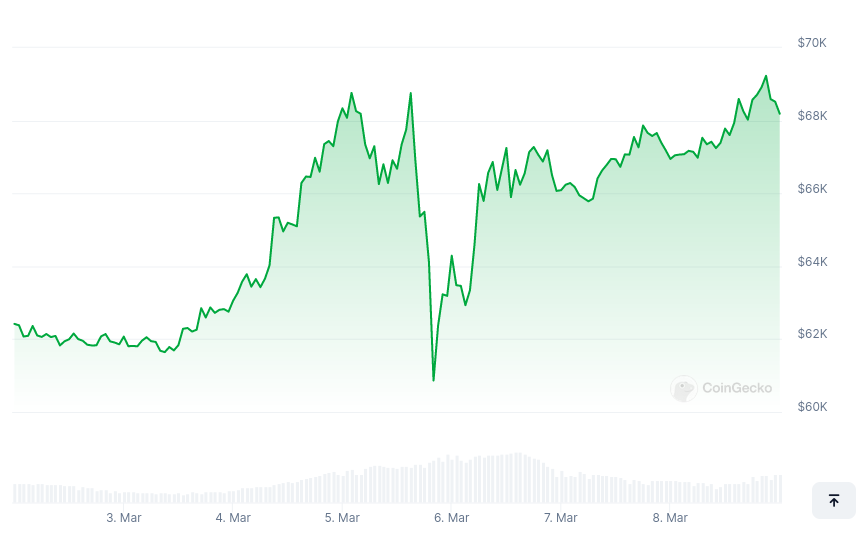ARTICLE AD BOX
Bitcoin (BTC) achieved two new all-time highs during the first full week of March 2024 amidst significant ongoing price growth.
On March 5, Bitcoin reached a new all-time high of $69,200. However, the cryptocurrency's value suddenly dropped below $60,900 in a matter of hours. Before the end of the day, the price had largely recovered by surpassing $66,000.
Bitcoin achieved a new all-time high for the second time just days later, though its exact value is debated. According to CoinMarketCap, BTC reached a new high of $70,083 at about 3 p.m. UTC on March 8. However, according to CoinGecko, BTC reached a high of $69,427 at 8:00 p.m. UTC the same day.

Each of those recent all-time highs exceeds the cryptocurrency’s earlier, November 2021 all-time high of $69,044.
Those highs are the result of long-term growth. As of March 8, the price of Bitcoin is up 54.1% over one month and 214.5% over one year.
Bitcoin’s main competitor, Ethereum (ETH), is still far from breaking its previous all-time high. ETH reached its latest high of $4,878.26 in November 2021. Although its price is trending upward, it is priced at just $3,908 as of March 8.
What Caused Bitcoin’s Rally?
Bitcoin's excellent performance may be driven by multiple factors. First, the approval of spot Bitcoin exchange-traded funds in January has affected supply and demand.
According to Bloomberg, after accounting for outflows, spot Bitcoin ETFs have experienced net inflows of $8.5 billion since launch. Those inflows restrict a significant portion of Bitcoin’s $1.3 trillion market cap, which may reduce the amount of BTC available for spot trading and cause Bitcoin prices can rise.
Lasting hype around exchange-traded funds may have also affected investor sentiment and encouraged investors to buy Bitcoin, thereby creating greater demand for available funds. Once again, this may increase prices.
On another note, Bitcoin’s upcoming halving may have impacted prices in advance. The halving occurs every four years and decreases miner rewards, thereby reducing Bitcoin issuance and price inflation. Some commentators suggest that this change is “priced in” as BTC's value often rises in advance of halving dates.
Anticipation concerning upcoming Federal Reserve meetings may also have impacted Bitcoin prices. Though the agency will likely maintain current rates in its next meeting, the possibility of rate cuts by July may be enough to encourage individuals to invest in BTC as a hedge against inflation.
.png)
 8 months ago
11
8 months ago
11








 English (US)
English (US)